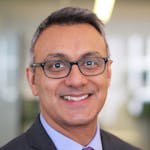People across America are using the Sustainable Development Goals as a road map to recover better by turning these global ambitions into local action.
For Hans Vestberg, the Chairman and CEO of Verizon, the SDGs are helping him align the company’s strategy with a broader vision for a better world. As head of the U.S.-based communications conglomerate, Vestberg knows that access to digital infrastructure and information technology is crucial for achieving the SDGs — both at home and abroad.
He recently sat down with the UN Foundation to share how his company is leading by example when it comes to private sector investment in the Global Goals.
Let’s start off by talking about the importance of sustainability. Why are the SDGs so important? And how do you think the SDG framework can help people in the U.S. work together to address our challenges?
Hans Vestberg: The SDG framework is about making the world a better place for everyone. That goes for the United States as well. There are so many challenges: climate change, poverty, hunger, disease, groups in our society that don’t have equal opportunities as others. We have a digital divide in this country right now that has been worsened by the pandemic. If you think about what has happened in the past 12 to 18 months, we have had horrible times, and we still have the pandemic around us.
At the same time, we’ve leapt ahead in usage of technology such as remote learning, telehealth, working from home. So that has opened up the digital divide even further. We now have the great chance of closing this digital divide by opening up access to this technology so no one is left behind.
The whole SDG framework addresses all of those challenges — regardless of where you are. You can utilize it as a corporation, as a person, as an NGO, as a public company. It doesn’t really matter. Everyone can align with these goals.
Why is Verizon committed to the SDGs, and what is the value of them for the organization?
HV: We have four stakeholders in everything we’re doing: our shareholders, our customers, our employees, and our society — and you cannot compromise between them. You need to see that you fulfill all of them.
For us, the SDGs are very much connected to how we do business, how we act in society, and how we show our employees that we have a purpose and we’re actually doing right for our society. All that is, for us, a cycle of interconnections: If we do right for employees, for our customers, in our society, ultimately, our shareholders are going to benefit as well. And that cycle for us is extremely important. And that’s how we drive this forward.
This is not philanthropy for us. This is part of our strategy of how we are meeting the demand for society and for shareholders, the same as we’re doing for our employees and our customers. This is what Verizon is doing every day, but it’s also serving our society. And that’s how we are connecting to the SDGs.
You said the central role of the SDGs is leaving no one behind. What does that mean for Verizon in practice?
HV: Our vision is to create the networks that connect the world together. So for us at Verizon, when we think about how we address these broader challenges in society, we created something called Citizen Verizon, which is basically three distinct pillars that support our SDG strategy: climate action, human prosperity, and, finally, digital inclusion.
So if you think about the digital divide, for example, we’re investing in networks in the most rural places of the country. We are bringing out new services there. That’s how we focus on accessibility. When it comes to affordability, we’re offering services like Fios Forward, which is a low-cost option for low-income families. Furthermore we’re working with many different organizations, such as the EDISON Alliance, which is a collaboration with the World Economic Forum, and the Broadband Commission for Sustainable Development, which is a UN organization to expand access to broadband across the globe.
And finally, when it comes to usability and access, we have Verizon Innovative Learning, a program that is providing free internet access, free devices, and innovative technology lessons in more than 400 schools across the country. We’re planning to invest more than $3 billion in this program between 2020 and 2025.
There can be this misconception that the SDGs are a bit complex and they are an additional thing for companies to report out on. But how do you best address that misconception with other CEOs?
HV: When I discuss the SDGs with other CEOs, one thing that is important for me to say is that this is a framework that every country — all 193 member countries at the UN — has signed on to. And these goals are actually to make this world a better place for each and every one of us — and that’s why it’s important that each and every one of us connect to them.
Because regardless of what business you have — private, public, NGO — there are different parts of the SDG framework that connect to your strategy and how you want to execute it.
Across the U.S. employees are putting a high priority on companies’ purpose, impact, and contributions to sustainability in the communities where they work and live. What are you hearing from your employees?
HV: Today’s employees are looking for your company’s purpose and how you impact different stakeholders. So we get many more questions from our employees about how Verizon is connecting our business strategy to society and climate change solutions: What are we doing as a company?
And all of this is interconnected with your strategy, and that’s a big difference from 10 or 15 years ago when the private sector was focusing on these connections more through philanthropy.
Today, we, as a corporation — which includes our employees, our customers, and our shareholders — are expecting that we’re actually connecting these broader goals to our core business strategy. So it’s a very different conversation.
What is this next phase of SDG leadership, particularly here in the U.S. and among the business community?
HV: In thinking about our long-term goal with the SDGs, we need collective action to reach our targets, because they’re so important for everyone, including here in the United States.
We need to work even closer within the public and private sectors to find solutions, because not one organization can solve it. We need collective work between NGOs, the private sector, and the public sector to solve some of the most challenging issues. And that also applies to the digital divide here in the United States. It takes collaboration so everyone has the same opportunities wherever you’re born or wherever you are.
Hans Vestberg is Chairman and Chief Executive Officer of Verizon Communications Inc. (NYSE, Nasdaq: VZ), which was formed on June 30, 2000 and is one of the world’s leading providers of technology, communications, information and entertainment products and services. Headquartered in New York City and with a presence around the world, Verizon generated revenues of $128.3 billion in 2020. The company offers data, video and voice services and solutions on its award-winning networks and platforms, delivering on customers’ demand for mobility, reliable network connectivity, security and control. He is also a Board member at the UN Foundation.
This conversation is part of a larger project launched by the UN Foundation and the Brookings Institution to build and support American leadership on the SDGs.
Sign up for our monthly newsletter to receive information about upcoming events, news, and stories that highlight American Leadership on the SDGs.



 View All Blog Posts
View All Blog Posts


